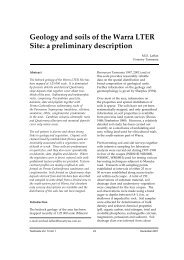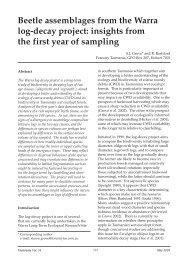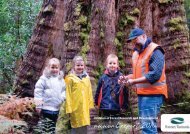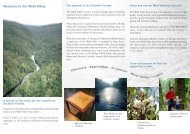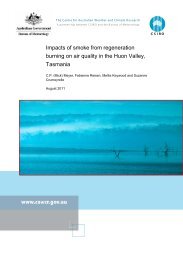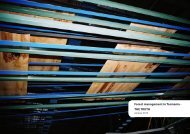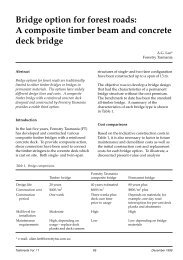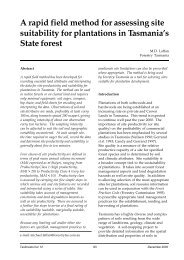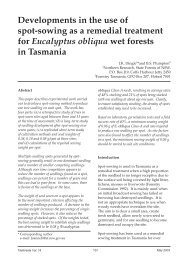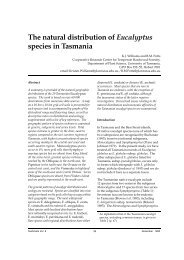sustainable forest management - Forestry Tasmania
sustainable forest management - Forestry Tasmania
sustainable forest management - Forestry Tasmania
You also want an ePaper? Increase the reach of your titles
YUMPU automatically turns print PDFs into web optimized ePapers that Google loves.
Environmental quality monitoring<br />
Air monitoring<br />
Planned burning is undertaken throughout <strong>Tasmania</strong> on<br />
private land and state <strong>forest</strong>s each autumn. Burning is<br />
dispersed and only a limited number of operations occur<br />
on any one-day. This burning is important to reduce the<br />
fuel hazard resulting from logging residue and to create<br />
a seedbed for eucalypt regeneration. Eucalypt seeds and<br />
seedlings need a mineral soil seedbed, abundant sunlight<br />
and reduced competition from other plants to establish<br />
and grow. In drier eucalypt <strong>forest</strong>, burning is undertaken<br />
to remove the residues remaining after harvesting so as to<br />
reduce the fuel load and fire hazard.<br />
Unfortunately, smoke is an inevitable product of this<br />
burning process. However, unlike the smoke from summer<br />
bushfires, a number of pro-active <strong>management</strong> options are<br />
available to assist in minimising the effects of this smoke<br />
on local communities. One of these options includes<br />
conducting burning operations on days where forecasted<br />
weather conditions indicate the smoke will be dispersed<br />
away from settled areas. To keep stakeholders informed<br />
about burning locations relevant information is provided<br />
through the <strong>Tasmania</strong>n planned burn website (www.<br />
plannedburnstas.com.au).<br />
National Environment Protection Measure (NEPM)<br />
monitoring of air quality occurs at Hobart, Launceston and<br />
Judbury. DPIW is responsible for monitoring the Hobart<br />
and Launceston stations, while <strong>Forestry</strong> <strong>Tasmania</strong> manages<br />
the Judbury site. The maximum concentration guideline<br />
for particles is 50µg/m 3 (PM 10<br />
), averaged over a 24-hour<br />
period. This is based on a level above which impacts on<br />
human health may be experienced. Measurements are<br />
taken at ground level. During 2007/08 the NEPM standard<br />
as measured by the Launceston monitoring station was<br />
exceeded three times, however, through correlation with<br />
the days on which <strong>Forestry</strong> <strong>Tasmania</strong> was conducting high<br />
and low intensity burns, it is unlikely that <strong>Forestry</strong> <strong>Tasmania</strong><br />
contributed to the exceeded levels.<br />
In the autumn of 2008 smoke <strong>management</strong> was complicated<br />
by weather conditions that saw the overly dry conditions<br />
change to overly wet, followed by a succession of high<br />
pressure systems that formed to the west and crossed the<br />
State in close succession. This brought sunny, still days and<br />
cold nights with strong temperature inversions.<br />
Landowners across the State used the calm period to<br />
undertake fuel reduction burning, and this, combined with<br />
burning undertaken by the <strong>forest</strong> industry, generated heavy<br />
smoke loads in susceptible parts of the State including the<br />
Tamar and lower Derwent valleys. The smoke produced<br />
by this burning was exacerbated by smoke produced by<br />
widespread burning in Victoria, which was carried at low<br />
level across <strong>Tasmania</strong> by the northerly winds associated<br />
with the high pressure systems. In consequence, <strong>Forestry</strong><br />
<strong>Tasmania</strong> suspended its autumn burning program for several<br />
days after 22 April, to allow an opportunity for conditions to<br />
improve.<br />
Table 12. Water testing associated with spray operations<br />
Water quality<br />
<strong>Forestry</strong> <strong>Tasmania</strong> has had a formal water quality sampling<br />
system in place since 1993. The system has been continually<br />
refined in the past decade based on operational experience<br />
and research findings. The use of pesticides and fertilisers<br />
must comply with the environmental protection measures<br />
prescribed in the Forest Practices Code. Section E2 of the<br />
code contains specific prescriptions covering watercourse<br />
protection. <strong>Forestry</strong> <strong>Tasmania</strong>’s water sampling policy states<br />
that water sampling is to be done following the broad scale<br />
application of pesticides and fertilisers. Three sets of water<br />
samples are taken: one sample set prior to application to<br />
establish any background contamination; the second after<br />
the application; and the third set of samples is taken following<br />
the first significant rain event after spraying has occurred to<br />
detect any contamination due to run-off and leaching.<br />
The health and guideline values for drinking water prescribed<br />
by the National Health and Medical Research Council<br />
(NHMRC) are used as the standards for determining the<br />
need for investigation and corrective action when pesticides<br />
are detected in water samples. Where no guideline values<br />
are prescribed for particular pesticides, <strong>Forestry</strong> <strong>Tasmania</strong><br />
uses any detection of the pesticide in water samples as the<br />
trigger for investigation. For the 2007/08 spraying season,<br />
139 samples were submitted for chemical analysis with no<br />
samples returning a positive result.<br />
2003/2004 2004/2005 2005/2006 2006/2007 2007/2008<br />
Number of samples associated with chemical spraying operations 361 410 635 302 139<br />
No. of detections and percentage of no chemical detections (15) 95.8% (3) 99.3% (1) 99.8% (0) 100% (0) 100%<br />
against ADWG Guideline Value 1 for chemical residues 2<br />
1. Australian Drinking Water Guidelines Health Value or any detection where no value indicated.<br />
2. Measured by DPIW testing laboratory.




